Welcoming the beauty of perennial flowers into your Vermont garden gives your yard a vibrant display of blooms year after year. In this article, we will explore the top perennial flowers in Vermont that flourish in the state’s cold climate and soil conditions.
From the splendid hues of coneflowers to the timeless beauty of daylilies, these flowers promise not only an annual spectacle of bloom but also a rewarding gardening experience. Get ready to add lasting vibrancy and charm to your garden year after year.
What Types of Flowers Thrive in Vermont?
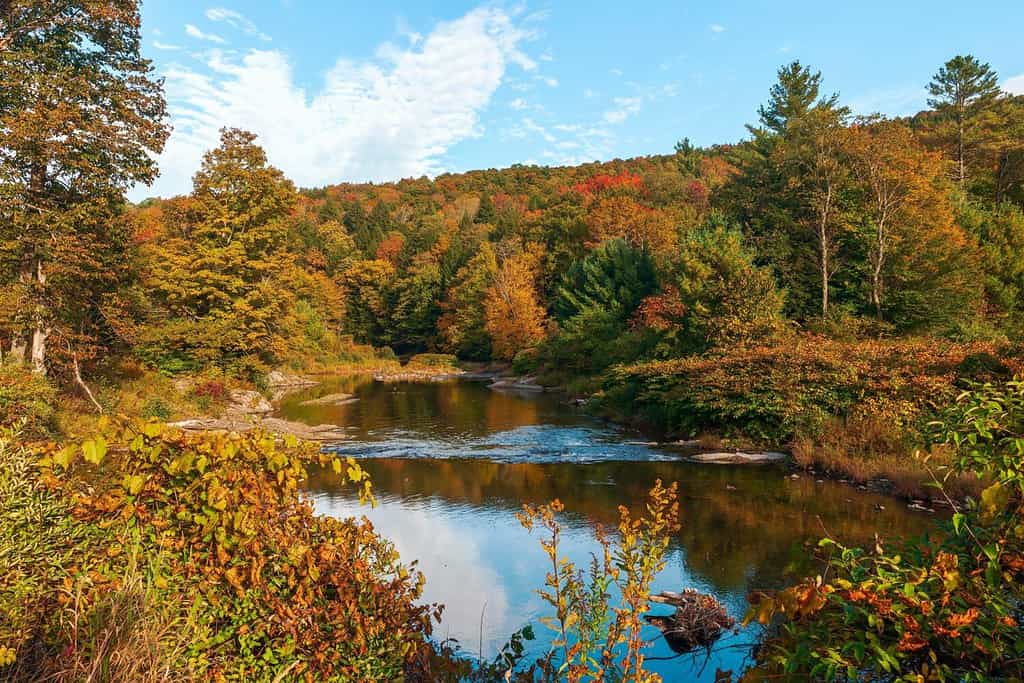
With long cold winters and short, relatively mild summers, Vermont undoubtedly has a cold climate.
©VIKVAD/Shutterstock.com
Vermont is located in the northeastern part of the US in New England. The state experiences harsh, snowy winters but has relatively warm summers. The winter in Vermont is long, with temperatures dipping below freezing at night until April. The coldest temperature ever recorded in the state is a jaw-dropping -50 degrees, so it goes without saying that perennials need to be resistant to the cold to survive in Vermont. Depending on your region in Vermont, you will be located in hardiness zones 3, 4, and 5. So, any plant that you attempt to grow in the state must be able to handle the USDA hardiness zone. As soil conditions go, Vermont has nutrient-rich, acidic soil that can support various plants and perennial flowers.
1. New England Aster (Symphyotrichum novae-angliae)

New England asters are a gorgeous perennial flower in Vermont that will attract pollinators, such as butterflies and honey bees, to your garden.
©iStock.com/McKinneMike
As one of the tallest and most vibrant asters, the New England aster stands as a robust, upright perennial with its multitude of daisy-like blooms. Each flower spans about 1.5 inches, showcasing rose-purple petals surrounding bright yellow centers. The blooms make their grand entrance in late summer and persist until frost, sitting atop sturdy stems adorned with dark green foliage.
Originating from North America, this plant is easy to grow in Vermont and has a notable lifespan, living for well over a decade when well cared for. The New England aster adds a splash of color to your flower garden and is an excellent source of nectar for butterflies.
During overcast days or nighttime, the flowers retreat and close. However, once the sun re-emerges, they resume their splendid show that lasts for weeks. This plant flourishes in full sun exposure in moderately moist and well-drained soil. For optimal growth, rich, moist soil is recommended. Ensure there’s adequate air movement around the plant to prevent foliar diseases such as powdery mildew.
2. Rough Goldernod (Solidago rugosa)
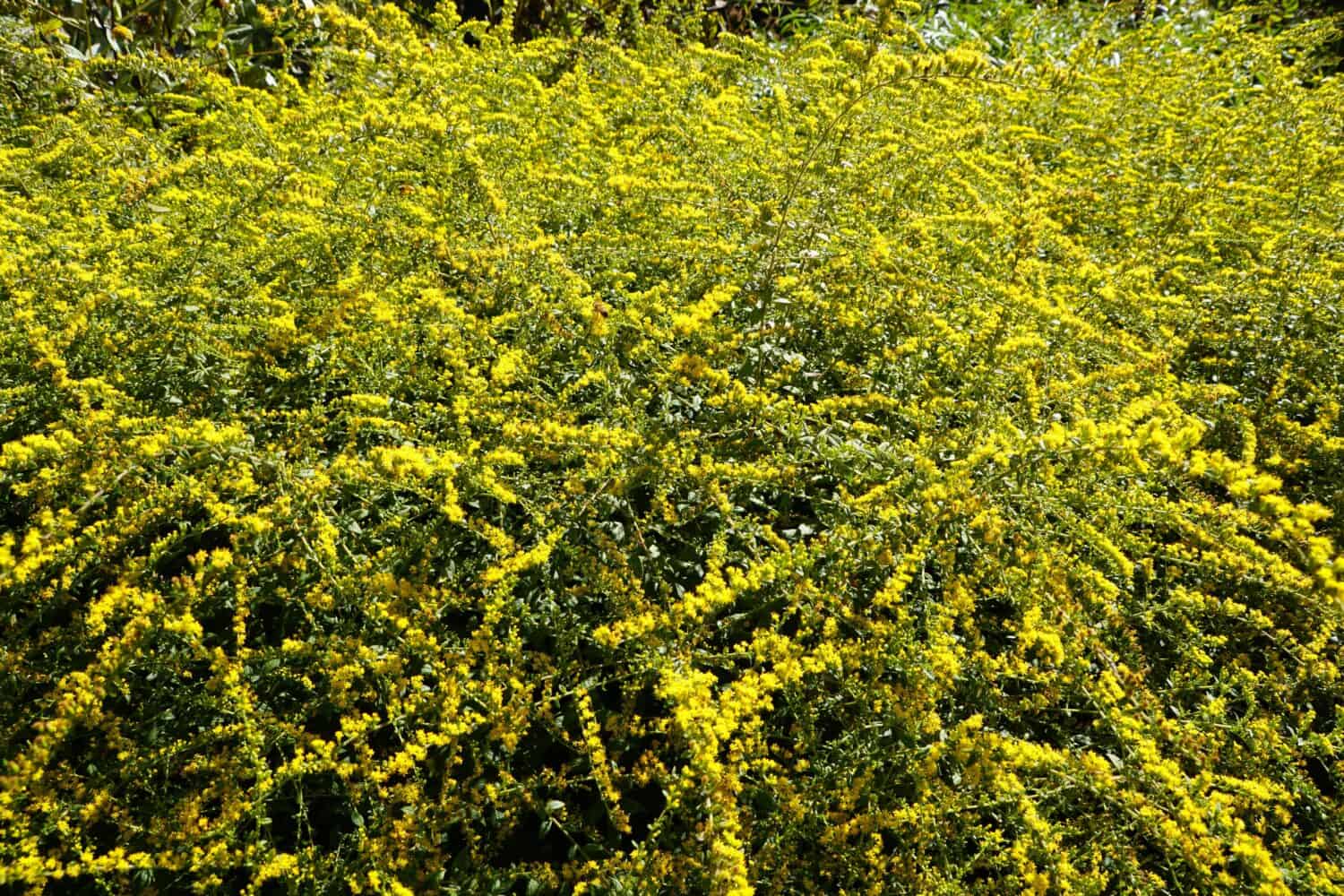
These yellow blooms appear in late summer and early fall in Vermont. Rough goldenrod is also exceptionally easy to care for.
©Khairil Azhar Junos/Shutterstock.com
The rough goldenrod is a compact, cascading perennial that forms attractive clumps, radiating with clusters of small, bright yellow flowers in the late summer and fall. Its charming blooms adorn the tips of textured, hairy stems that are lined with ovate to lance-shaped, sharply notched, green leaves up to four inches long.
This plant’s nectar and pollen also invite and sustain a diverse array of beneficial insect species.
With its easy cultivation, low maintenance, and general hardiness, it’s an ideal selection for sun-kissed borders or natural areas in Vermont.
This flower thrives best in full sunlight to mild shade, preferring average, slightly acidic, medium to damp, and well-draining soil conditions. It’s adaptable and can thrive in various soil types, including clayey and moist soils.
3. Virginia Spiderwort (Tradescantia virginiana)

With beautiful purple and yellow blooms, the Virginia spiderwort is a gorgeous addition to any flower bed in Vermont.
©Nikolay Kurzenko/Shutterstock.com
The Virginia spiderwort is a vibrant, clump-forming perennial with elongated, bright green leaves that either stand erect or curve gracefully. Between late spring and midsummer, the foliage is crowned by small groups of three-petaled flowers.
Each flower spans up to two inches and radiates with hues of violet-blue to purple, made even more striking by their prominent yellow stamens. Each flower’s life is a day-long spectacle, but due to the plant’s plentiful buds, it’s hardly ever without blooming flowers.
The Virginia spiderwort enters a dormant phase during the summer. It pairs well with late-blooming perennials to maintain continuity in the blooming cycle. This plant thrives in fertile, dry to slightly damp, well-drained soils and prefers partially shaded areas. It can also withstand full sunlight or complete shade.
4. Basket of Gold (Aurinia saxatilis)
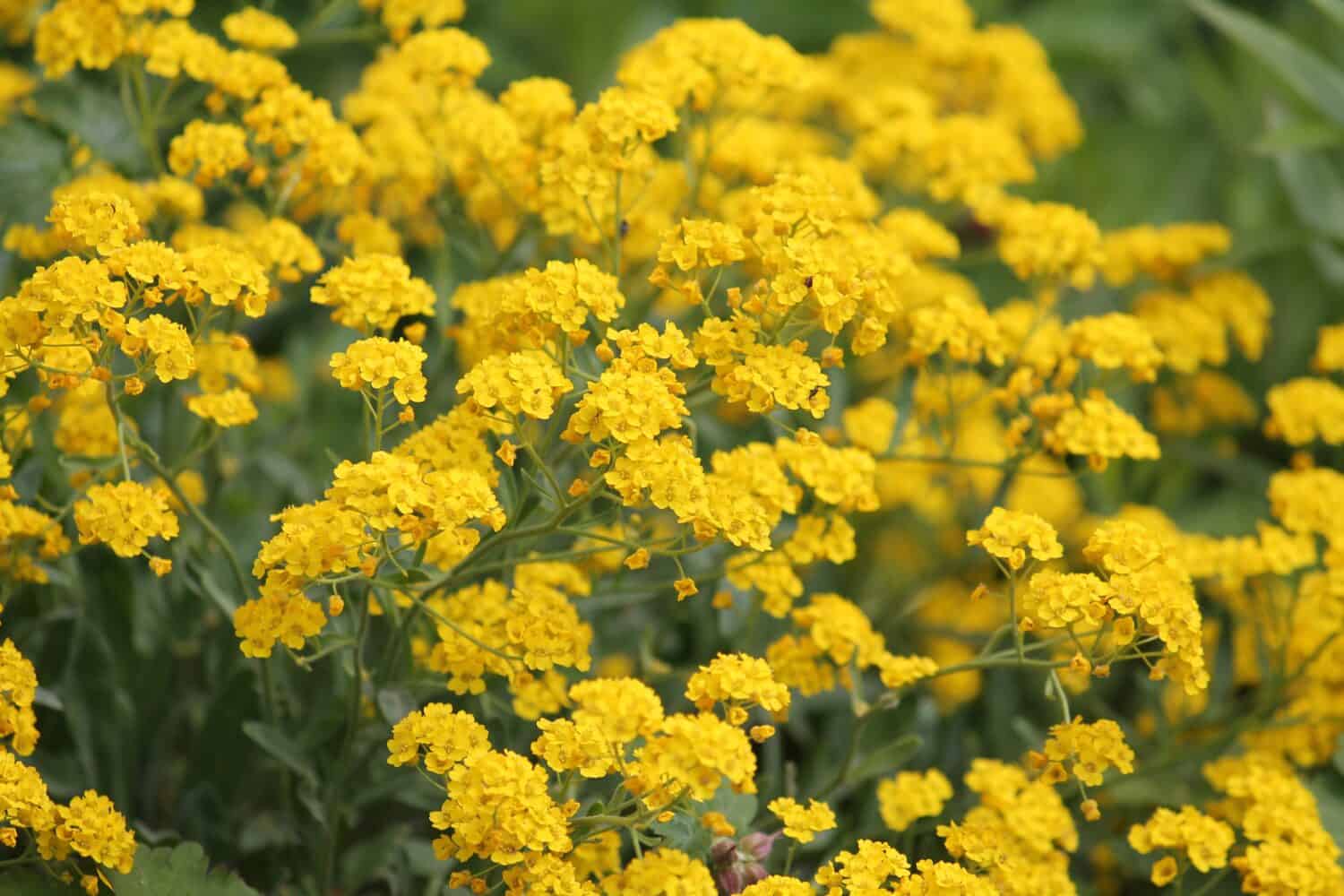
The basket of gold is a yellowish flower that survives well as a perennial in Vemont’s harsh conditions.
©Kazakov Maksim/Shutterstock.com
In Vermont, the basket of gold is a delightful, low-growing perennial flower that deserves your attention. Basket of gold gives your garden a continuous display of its rich, golden-yellow flowers for a generous four to six weeks in the spring, creating a striking contrast with its gray-green foliage.
This mat-forming plant is exceptionally appealing in rock gardens or spilling over raised bed edges. EIt maintains its appeal even after its blooming season, transitioning into an attractive ground cover. Its beauty and resilience have earned it the respected Award of Garden Merit from the Royal Horticultural Society.
This plant thrives in full sun and prefers dry, average to sandy, well-drained soil conditions. It appreciates some shade during hot afternoons. Avoid planting it in heavy clay soils or wet, poorly drained areas. Plus, it’s a great choice if you’re looking for a deer-resistant plant.
5. Mountain Cornflower (Centaurea Montana)
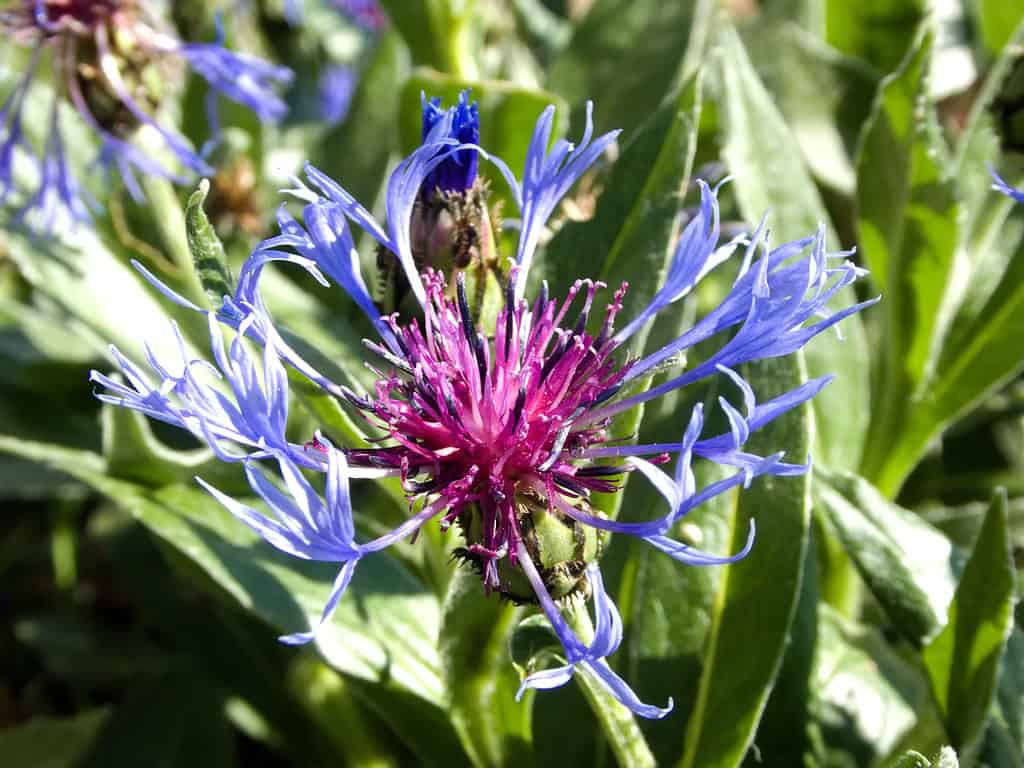
Mountain cornflower is a unique flower with blue and red blooms. This flower originated, also known as mountain bluet, originated in Europe but also thrives in Vermont.
©Hjochen/Shutterstock.com
Cherished for its vibrant, royal blue blossoms, the mountain cornflower is a sturdy, clump-forming perennial with a spreading habit. Its 2-inch-wide fringed flowers, sporting reddish-blue centers reminiscent of thistles, put on a show from late spring to early summer.
Originally from Europe, this perennial plant spreads via its rhizomes. It tends to self-seed prolifically, and if not deadheaded, it can spread quite rapidly, forming dense colonies under favorable growth conditions.
The mountain cornflower grows best in full sun to partial shade in average, dry, moderately moist, well-drained soils. It’s also a tough flowering plant that tolerates poor soil conditions and is resistant to heat and drought.
6. Red Valerian (Centranthus ruber)
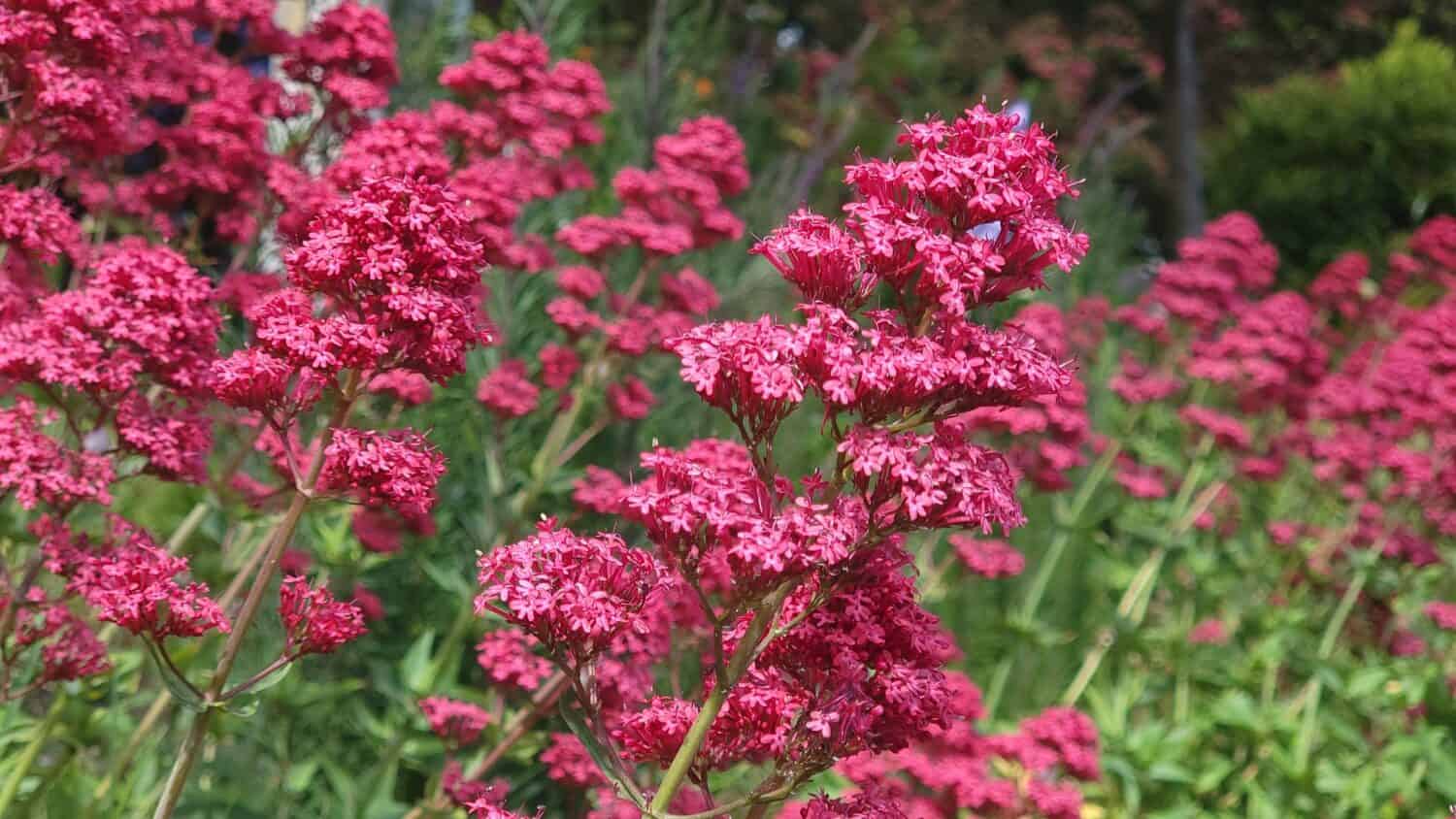
Red valerian is a striking perennial that also has interesting medicinal properties, known to help people sleep.
©Wirestock Creators/Shutterstock.com
Renowned for its bushy structure, extensive branching, and extended flowering period, the red valerian is a much-loved perennial in Vermont. Red valerian is a popular perennial flower in Vermont, celebrated for its decorative, star-shaped blossoms. Besides its fragrant beauty, this border standout is also straightforward to cultivate, generally free from pests and diseases, and serves as a butterfly magnet.
This plant flowers profusely from the beginning of summer right into the fall, showcasing plentiful rounded clusters of flowers in hues ranging from deep crimson to pink or white.
The red valerian thrives in full sun, though it can tolerate some shade, and prefers average to sandy, moderately moist, well-drained soils. It’s a tough plant that can prosper even in poor soil conditions. While it copes well with drought, it isn’t fond of hot and humid summers.
Fun fact: The root of the valerian plant is popularly used in herbal medicines to aid in sleep.
7. Whorled Tickseed (Coreopsis verticillata)
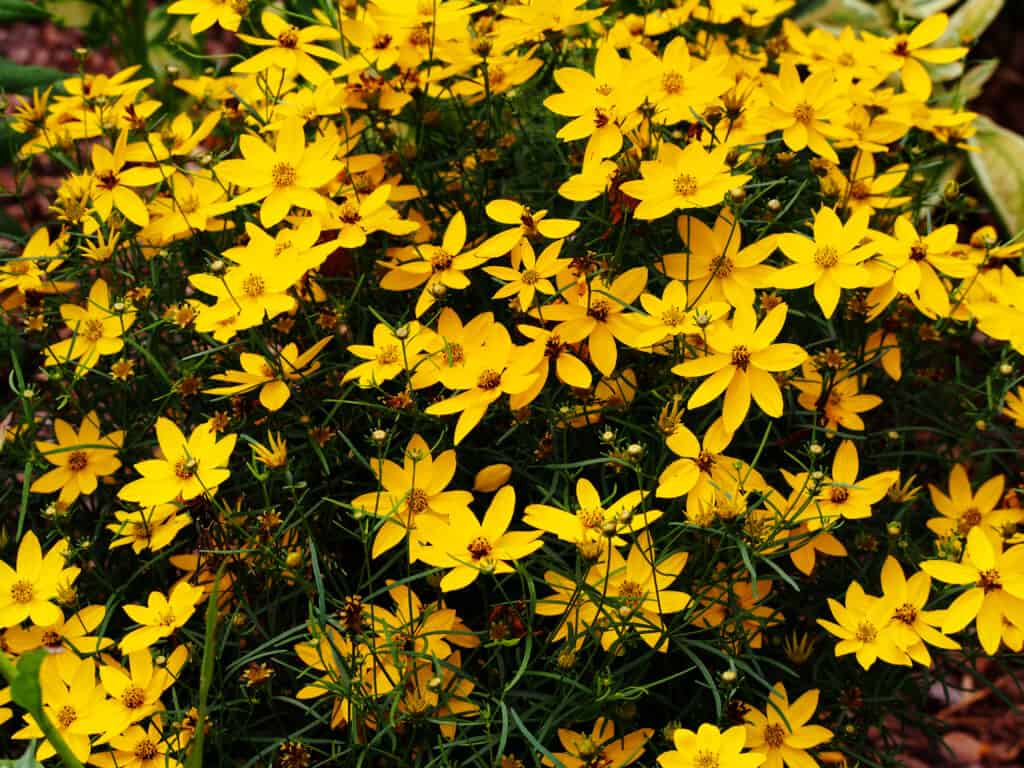
This beautiful yellow perennial flower is whorled tickseed. The blooming period lasts throughout the summer in Vermont.
©iStock.com/Gratysanna
Recognized as a study perennial flower, the whorled tickseed is a compact plant that forms a beautiful mound of finely cut foliage. Its blooming period extends from the early to late summer, during which it gets adorned with an abundance of one-inch-wide, buttery yellow flowers. The light, feathery foliage clumps stand on upright stems and contribute to your garden by adding a lovely, subtle texture.
This plant was honored with the 1992 Perennial Plant of the Year Award.
While it thrives best under full sun, it can also tolerate partial shade, especially in areas prone to hot summers. It prefers dry to medium moisture, well-drained soils and even flourishes in poor, sandy, or rocky soil conditions. This plant is drought-resistant but tends to spread if grown in moist and fertile soils.
8. Queen of the Prairie (Filipendula rubra)
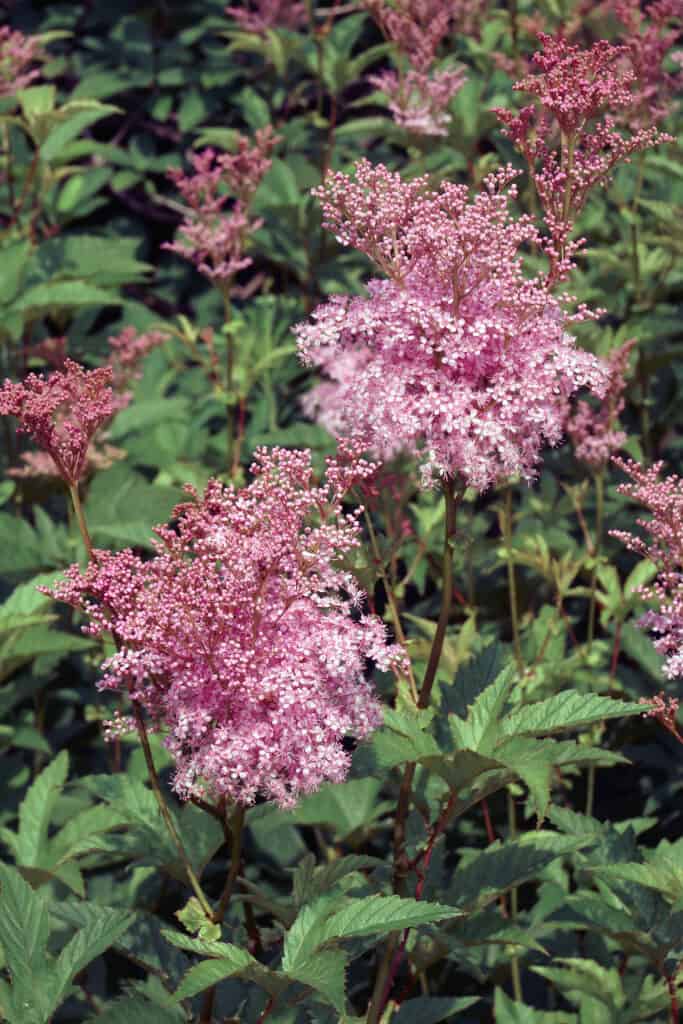
Queen of the prairie is a tall and pink perennial flower that can grow throughout Vermont.
©iStock.com/nickkurzenko
Impressively tall and striking, the award-winning queen of the prairie is an exquisite perennial plant with large, refined sprays of small deep pink flowers. These flowers stand high above the foliage on leafy stems from early to late summer. The delicate flowers, which mature from deep to pale pink, emit a pleasant fragrance, as do the plant’s deeply cut, bright green leaves. This resilient, long-lasting native U.S. perennial is known for both its fragrant leaves and blooms.
The queen of the prairie received an Award of Garden Merit from the Royal Horticultural Society.
This plant flourishes in full sun or partial shade in fertile, humus-rich, and moist soils, whether well-drained or poorly drained. Consistent watering is essential, as this plant cannot tolerate drought, helping its foliage to stay appealing throughout the growing season. In hot climates, the plant appreciates some shade.
9. Globe Thistle (Echinops)

This intriguing ball-shaped flower is sturdy and hardy. The plant adapts well to various conditions and soil types.
©Alex Manders/Shutterstock.com
The globe thistle brings exceptional contrast and color to your summer garden. It’s not only free from diseases and low maintenance, but it also significantly enhances the landscape. Its flowering period extends from mid-summer to early fall, featuring striking steel-blue or immaculate white, ball-shaped flowers similar in size to a golf ball.
These blooms are nothing short of captivating. Held up on sturdy stems, they elegantly sway above their attractive foliage of dark green leaves reminiscent of thistles.
This plant can adapt to different soil types, including chalk, loam, and sand, and can tolerate a range of soil pH levels from acidic to alkaline to neutral. It prefers well-drained soil conditions. As for light exposure, the globe thistle thrives in full sun but can also tolerate partial sun.
10. False Sunflower (Heliopsis helianthoides)
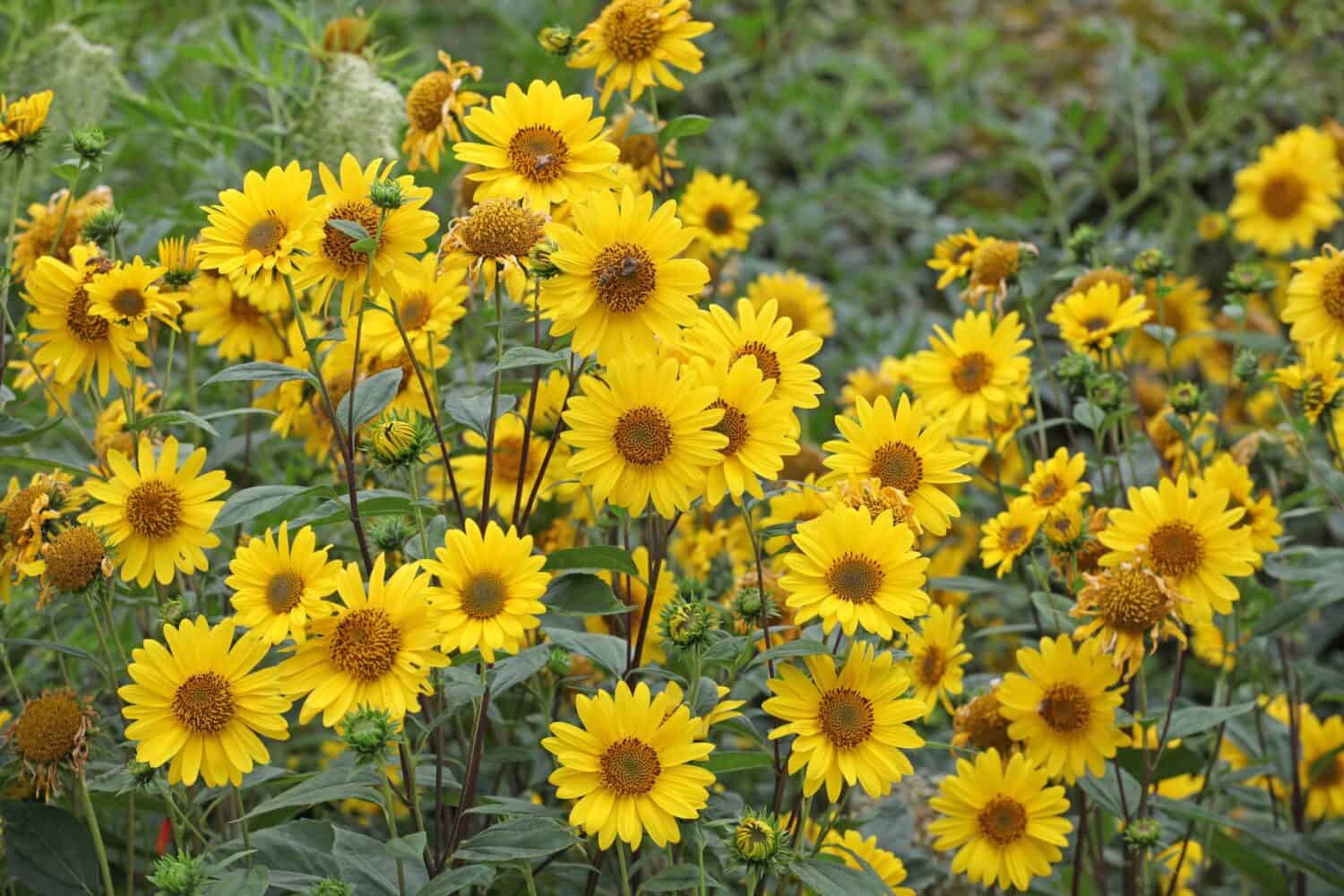
The false sunflower, as the name suggests, looks like a common sunflower but, in fact, is a different species entirely.
©Alex Manders/Shutterstock.com
While it may look similar, the false sunflower is not related to the common sunflower (Helianthus annuus). Beloved for their sunlight-loving nature, effortless growth, hardiness, and resilience to heat and drought, the false sunflowers are brimming with attractive features. These flowers make a significant contribution to your garden with their abundance of vivid golden daisies spanning 2-3 inches wide. Their flowering season lasts for six to eight weeks, extending throughout the summer until the early fall.
These flowers serve as the perfect choice to add a pop of color to a sunny garden spot or a vase, where they’ll stay fresh for a couple of weeks!
They are sun-loving plants that thrive in average, dry to medium, well-drained soil conditions. They are not picky about the soil type and can grow in a wide variety, including poor soil. However, they yield the best results in reasonably fertile, consistently moist, and well-drained soils.
11. Daylilies (Hemerocallis)
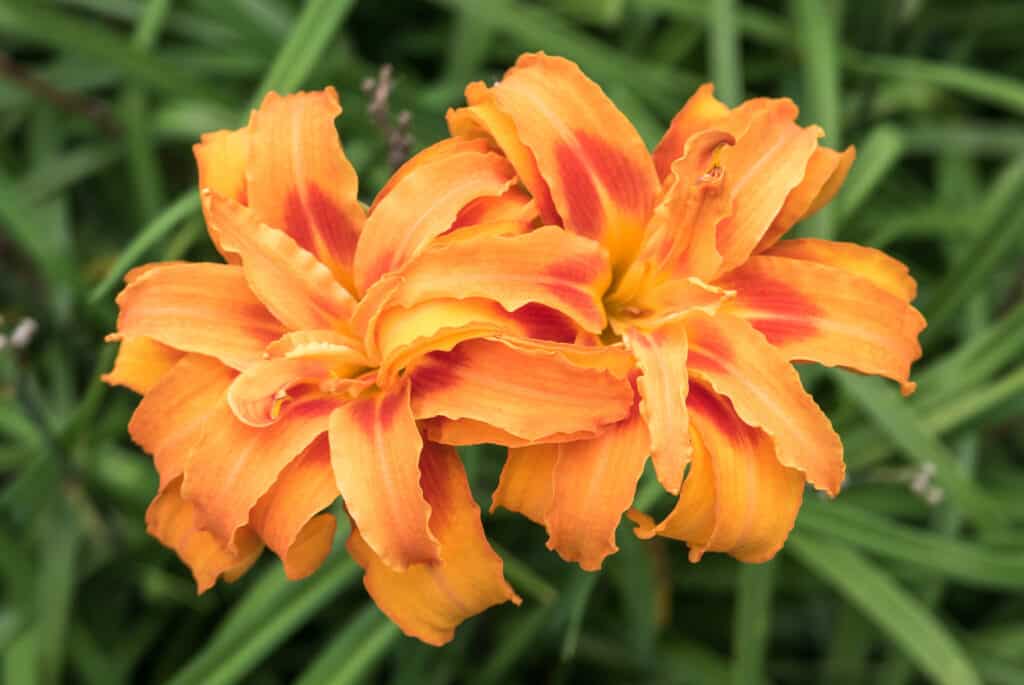
These beautiful flowers can come in a wide variety of colors, making them a great addition to your garden.
©iStock.com/lrosebrugh
Daylily, frequently referred to as the ‘ideal perennial,’ earns this title due to its multitude of appealing attributes: vibrant and eye-catching blossoms, a broad spectrum of vivid hues, adaptability to drought and heat stress, suitability for various hardiness zones, and minimal care needs.
Despite their relatively brief bloom period, typically between one and five weeks, daylilies can potentially bloom from the early spring until the onset of frost, depending on their variety and region. Planting diverse types can ensure a prolonged flowering period, keeping your garden vibrant. Originating from Eurasia, there are over 60,000 registered daylily cultivars, providing an extensive selection for gardening enthusiasts.
Daylilies flourish under full or partial sunlight in typical, moist, well-drained soils, and they encounter very few pest issues. Although they are tolerant of diverse soil types, they prefer fertile loam.
12. Japanese Iris (Iris ensata)
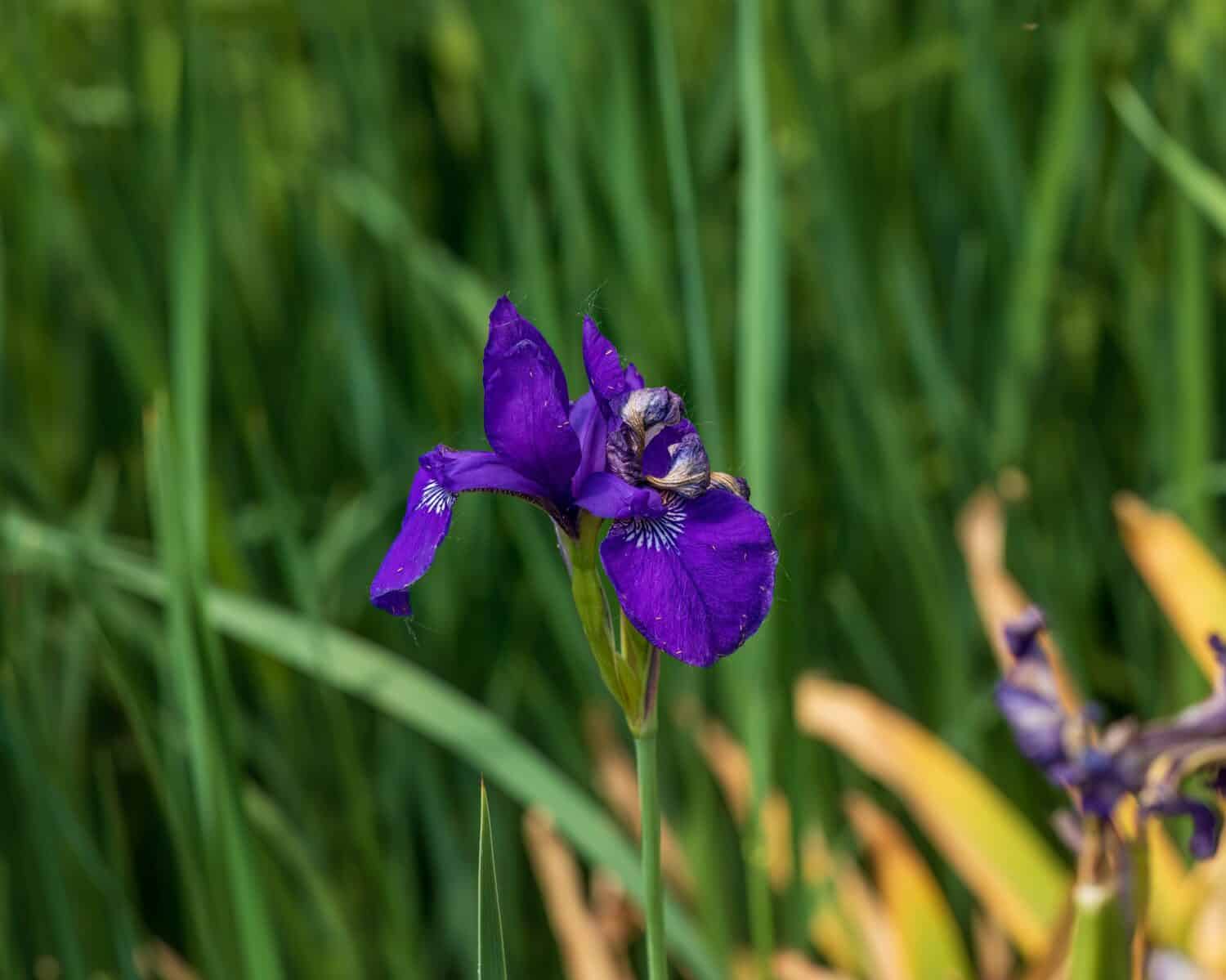
A flower that has been cultivated for millennia in Japan is the Japanese iris. That said, it can also grow and thrive in various other regions, including Vermont.
©Mark R Coons/Shutterstock.com
As the name suggests, the Japanese iris hails from Japan. Japanese irises are among the most sophisticated and stunning varieties of Irises. This flower is another perennial flower that can be grown in Vermont.
More graceful and understated than the tall bearded irises, these beardless irises boast large, orchid-like blossoms. The flowers, typically ruffled and flat, stand tall on firm, erect stems, emerging from a thick bunch of linear, sword-like green leaves, which can grow up to 24 inches long and feature prominent midribs. These plants have been grown in Japan for over half a millennium, where they are known as Hanashobu.
Japanese irises bloom from early to mid-summer and are the final type of iris to flower each year. They thrive in locations with full sun or partial shade and prefer humus-rich, medium to wet, acidic soil conditions.
13. English Lavender (Lavandula angustifolia)
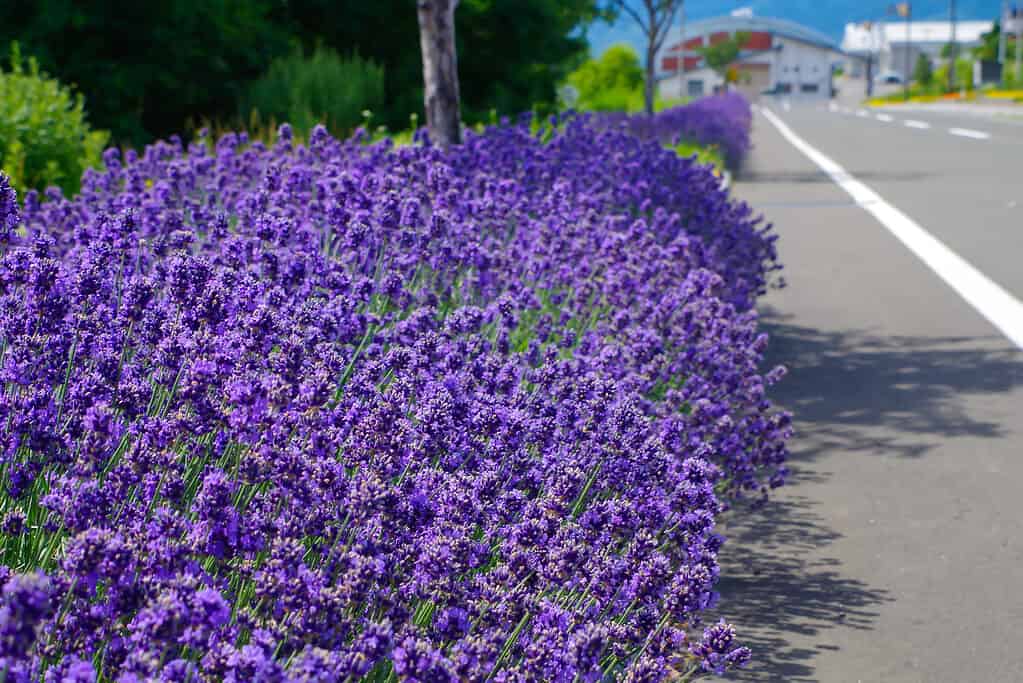
A fragrant flower that is also used in essential oils is English Lavender.
©ajisai13/Shutterstock.com
English lavender is a slightly different species than French Lavender. That said, this plant does not actually originate from the United Kingdom but instead from the Mediterranean region. The plant is called English lavender due to its ability to survive and thrive in England and its overall popularity there. The good news? English lavender is a very sturdy perennial flower that also does very well in Vermont. Perfect for adding charm to garden borders and creating aromatic potpourri, this particular type of lavender is also renowned for producing top-quality oils.
When you pass by or crush its leaves, English lavender releases a relaxing scent. It is praised for its airy flower spikes, which emerge on the tips of each upright stem, creating mesmerizing waves of cool hues that flutter in the summer wind. The flowering season usually kicks off in early to mid-summer, lasting around three or four weeks.
This plant thrives best in full sun exposure and requires moderate upkeep. It’s adaptable to a range of soil types, including chalk, loam, and sand.
14. Shasta Daisy (Leucanthemum × superbum)

The simple but beautiful Shasta daisy is a sign of summer in Vermont.
©Heeji Choi/Shutterstock.com
The Shasta daisy is a beloved perennial plant cherished for its strikingly bold flower display and its appealing, lush, dark green leaves. It provides weeks of color from early or mid-summer, making it a fantastic and easy-to-care-for addition to any Vermont garden. This perennial thrives in hardiness zone 5, which is located in the southern regions of Vermont.
With a myriad of available cultivars, there’s a shasta daisy out there to suit every garden and every gardener’s preference. These variations offer a range of plant compactness, flower size, bloom types (single or double), lifespan, and re-blooming periods.
These plants flourish best in full sun, preferring rich, moist, and well-drained soil conditions. They can tolerate light shade, especially in regions experiencing hot summers.
15. Oriental Poppy (Papaver orientale)

Oriental poppies grow in the early summer months in Vermont and add a lot of character to any garden.
©Ole Schoener/Shutterstock.com
Another spectacular perennial flower for Vermont is the oriental poppy. When late spring transitions to early summer, oriental poppies truly become the stars of the garden. Their large, satin-like blossoms, in hues of red, orange, pink, or white, are a sight to behold. When these plants are grouped together, their vibrant blooms create a stunning visual impact.
These plants form clusters that grow to be 2-3 feet tall and wide, with flowers generally spanning 4-6 inches in width. These blossoms are characterized by purple-black centers and are supported by stems covered with silvery-green, thistle-like leaves.
They flourish in full sun and are comfortable in various soil types, such as chalk, clay, loam, and sand. They can adapt to a range of soil pH levels, whether it’s acidic, alkaline, or neutral, as long as the soil is well-drained.
Summary of Best Perennial Flowers for Vermont
| Number | Flower | When to Plant | Blooming Period |
|---|---|---|---|
| 1 | New England Aster | Spring to early fall | Late summer to first frost |
| 2 | Rough Goldenrod | Fall or spring | Late summer to fall |
| 3 | Virginia Spiderwort | Spring | Late spring to midsummer |
| 4 | Basket Of Gold | Late summer or fall | Spring |
| 5 | Mountain Cornflower | Spring | Late spring to early summer |
| 6 | Red Valerian | Spring through fall | Early summer to fall |
| 7 | Whorled Tickseed | Spring or fall | Early to late summer |
| 8 | Queen Of The Prairie | Late summer or fall | Early to late summer |
| 9 | Globe Thistle | Midsummer | Midsummer to early fall |
| 10 | False Sunflower | Early spring or early fall | Summer to fall |
| 11 | Daylilies | Late spring or early fall | Early spring to fall |
| 12 | Japanese Iris | Fall | Early to midsummer |
| 13 | English Lavender | Early spring | Early to midsummer |
| 14 | Shasta Daisy | Early spring or fall | Summer to early fall |
| 15 | Oriental Poppy | Mid to late summer | Late spring to early summer |
Thank you for reading! Have some feedback for us? Contact the AZ Animals editorial team.







